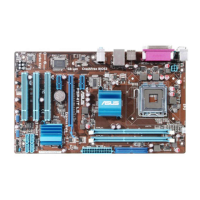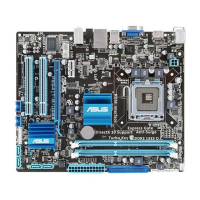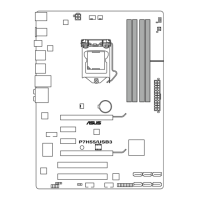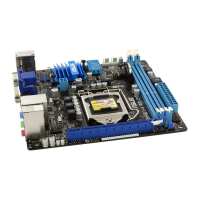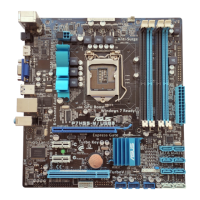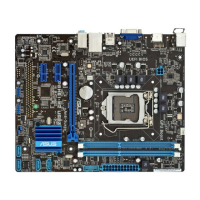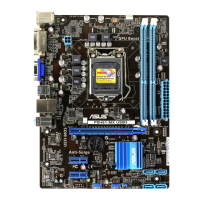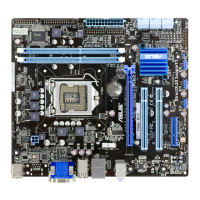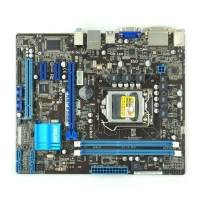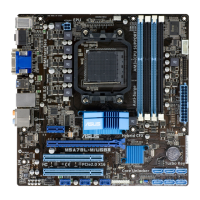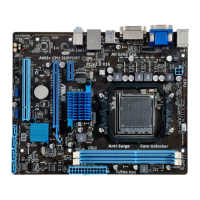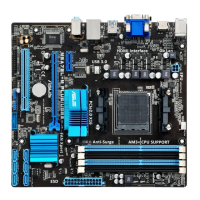Do you have a question about the Asus P5P41T USB3 and is the answer not in the manual?
Details FCC compliance and operational conditions for digital devices.
Confirms digital apparatus compliance with Canadian radio noise emission limits.
Information on compliance with REACH regulations and product recycling.
Guidelines to prevent electric shock hazards during system handling and setup.
Best practices for handling and installing the motherboard to prevent damage.
Explains the structure of the manual and its purpose.
Key symbols indicating danger, caution, and important instructions for safe operation.
Provides supplementary information and helpful tips for completing tasks.
Directs users to ASUS websites and optional documentation for further details.
Explains formatting like bold text, italics, and key notations used in the manual.
Details compatible Intel processors and related technologies.
Lists the Northbridge and Southbridge chipsets used on the motherboard.
Specifies supported Front Side Bus frequencies.
Details DDR3 memory support, channels, and capacity.
Lists available PCI, PCIe x1, and PCIe x16 slots.
Details SATA and IDE connector support.
Specifies the onboard Gigabit LAN controller.
Details the onboard audio codec.
Lists available USB 2.0 and USB 3.0 ports.
Highlights proprietary ASUS technologies for performance and management.
Lists all external connectivity ports on the rear panel.
Details onboard connectors for fans, power, and front panel headers.
Summarizes BIOS capabilities and standards supported.
Lists system management and wake-up features.
Lists items provided in the motherboard package.
Details drivers, software, and utilities included on the support DVD.
Specifies the physical dimensions of the motherboard.
Lists items included in the motherboard package for verification.
Details key features and technologies of the P5P41T/USB3 motherboard.
Describes proprietary ASUS technologies enhancing performance and usability.
Explains the instant-on OS for quick internet and application access.
Allows customization of the boot logo with user-selected images.
Details the auto-recovery tool for restoring corrupted BIOS files.
Explains intelligent CPU fan speed adjustment for optimal cooling and quiet operation.
Utility for updating the BIOS directly without an operating system.
Features remote detection of LAN cable connection status and faults.
Automates overclocking for enhanced system performance.
Automatically restores CPU settings after overclocking failure.
Highlights compliance with environmental regulations like RoHS.
Explains the function of the motherboard's standby power LED.
Guidance on orienting the motherboard correctly within the chassis.
Identifies screw holes for securing the motherboard to the chassis.
Visual representation of motherboard components and connectors.
Index of motherboard connectors, jumpers, and slots with page references.
Step-by-step instructions for installing a CPU into the LGA775 socket.
Procedure for mounting the CPU heatsink and fan assembly.
Instructions for safely removing the CPU heatsink and fan assembly.
Introduction to the motherboard's DDR3 DIMM sockets and memory types.
Details on installing various memory sizes and dual-channel configurations.
Procedure for inserting a DIMM module into a socket.
Procedure for safely removing a DIMM module from a socket.
Steps for installing various expansion cards into available slots.
Guidance on software settings and IRQ assignments for expansion cards.
Details on types of cards supported by PCI slots.
Details on cards supported by PCI Express x1 slots.
Details on graphics cards supported by the PCIe x16 slot.
Procedure for clearing CMOS settings using the RTC RAM jumper.
Description and function of rear panel I/O ports.
Details on internal headers for fans, power, and USB connections.
Guidance on installing supported Windows OS versions and updates.
Details on drivers and software included on the support DVD.
Procedures for saving, managing, and updating the motherboard BIOS.
Using the utility to update the BIOS from Windows.
Updating the BIOS directly from the BIOS setup utility.
Utilizing the recovery tool for corrupted BIOS files.
Explains the layout and elements of the BIOS setup interface.
Describes the main menu items and how to navigate them.
Details the keyboard keys used for navigating BIOS menus.
Explains how menu items and submenus are displayed and accessed.
Describes how to view and change configurable BIOS settings.
Explains how pop-up windows display configuration options.
Details how to use scroll bars to view all items on a screen.
Explains the location and purpose of the general help text.
Allows setting the system's current time.
Allows setting the system's current date.
Displays and allows configuration of detected IDE/SATA devices.
Settings for ATA/IDE controllers and SATA mode.
Shows auto-detected BIOS, CPU, and memory information.
Adjusts system frequency and voltage for performance tuning.
Details CPU-related features like C1E, Virtualization, and TM function.
Advanced settings for North and South bridge chipsets.
Enables/disables onboard peripherals like LAN and audio.
Settings for USB functions, controllers, and legacy support.
Manages PCI/PnP device resources like IRQ and DMA.
Configures ACPI states for system suspend and sleep modes.
Enables additional tables for Advanced Configuration and Power Interface.
Enables APIC support for interrupt handling.
Enables over-voltage protection for sensitive components.
Settings for power management features like AC power loss restore.
Displays system temperatures, fan speeds, and voltages.
Sets the sequence of bootable devices.
Options for Quick Boot and Full Screen Logo display.
Manages BIOS passwords and user access levels.
Utility for updating the BIOS directly from the BIOS setup utility.
Enables or disables the ASUS Express Gate instant-on OS.
Checks Realtek LAN cable status during POST.
Saves modified BIOS settings and exits the setup utility.
Discards all changes and exits the setup utility.
Reverts settings to the last saved values without exiting.
Resets all BIOS parameters to their default factory settings.
Provides contact details for ASUS headquarters in Taiwan.
Provides contact details for ASUS America operations.
Provides contact details for ASUS operations in Germany and Austria.
Statement of compliance with FCC rules for the motherboard.
Statement of compliance with relevant European directives.
| Socket | LGA 775 |
|---|---|
| Chipset | Intel P41 |
| Form Factor | ATX |
| Memory Slots | 4 x DIMM |
| Maximum Memory | 8GB |
| North Bridge | Intel P41 |
| South Bridge | Intel ICH7 |
| Max. LAN Speed | 10/100/1000 Mbps |
| USB Ports | 12 |
| USB 3.0 Ports | 2 x USB 3.0 |
| Audio | 8-channel HD Audio |
| Expansion Slots | 1 x PCIe x16 2 x PCIe x1 3 x PCI |
| CPU Type | Intel Core 2 Quad / Core 2 Duo / Pentium |
| Memory Standard | DDR3 1333/1066/800 |
| SATA 3Gb/s | 4 |
| Audio Ports | 3 |
| Dimensions (W x L) | 30.5 cm x 24.4 cm |
| Power Pin | 24-pin ATX + 4-pin ATX12V |
| LAN Chipset | Realtek RTL8112L |
